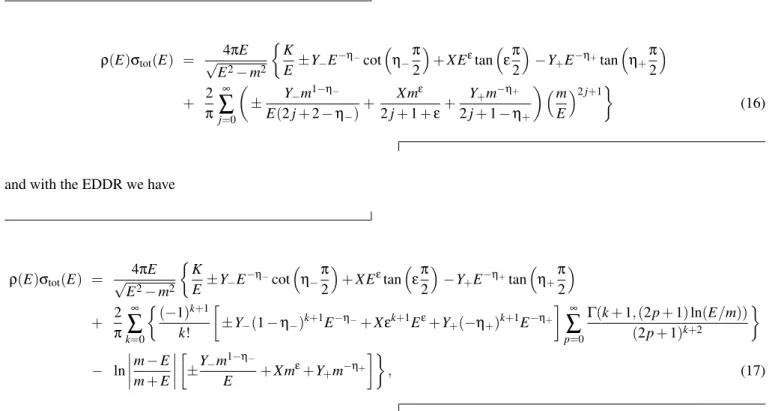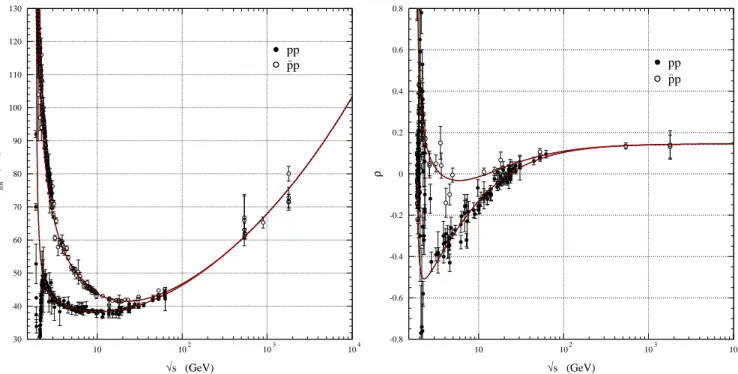Brazilian Journal of Physics, vol. 37, no. 2B, June, 2007 661
From Integral to Derivative Dispersion Relations
R. F. ´Avila
Instituto de Matem´atica, Estat´ıstica e Computac¸˜ao Cient´ıfica Universidade Estadual de Campinas, UNICAMP
13083-970 Campinas, SP, Brazil
and M. J. Menon Instituto de F´ısica Gleb Wataghin Universidade Estadual de Campinas, UNICAMP
13083-970 Campinas, SP, Brazil
Received on 24 March, 2006
We demonstrate that integral dispersion relations for hadron-hadron scattering amplitudes can be replaced by differential relations, without the usual high-energy approximation. We obtain analytical expressions for the corrections associated with the low energy region and exemplify the applicability of the novel relations in the context of an analytical parametrization for proton-proton and antiproton-proton total cross sections.
Keywords: Elastic hadron scattering; Dispersion relations; High energies
I. INTRODUCTION
Dispersion relations constitute a fundamental mathemati-cal tool in several areas of Physics. In special, in particle-particle and particle-particle-antiparticle-particle interactions, the correlation between the real and imaginary parts of the scattering am-plitude play an important role in the investigation of forward elastic hadron-hadron interactions.
Analyticity, Unitarity and Crossing lead toIntegral Disper-sion Relations (IDR) for the scattering amplitudes in terms of a crossing symmetrical variable. For an elastic process, m+m→m+m, in the forward direction, this variable corre-sponds to the energy of the incident particle in the laboratory system,E. In this context the one subtracted IDR for crossing even (+) and (−) odd amplitudes, above the physical thresh-old (E=m), read [1, 2]
ReF+(E) =K+2
E2
π P
Z +∞
m
dE′ 1
E′(E′2−E2)ImF+(E′), (1)
ReF−(E) =2E
π P
Z +∞
m
dE′ 1
(E′2−E2)ImF−(E′), (2) whereKis the subtraction constant.
The connections with the hadronic amplitudes for crossed channels, such as proton-proton (pp) and antiproton-proton ( ¯pp) elastic scattering, are given by the usual definitions:
Fpp=F++F− Fpp¯ =F+−F−. (3)
The main practical use of the IDR concerns simultaneous investigations on the total cross section (Optical Theorem) and the ratioρ of the real to imaginary parts of the forward am-plitude. In terms of the crossing symmetrical variableEthese physical quantities are given, respectively, by [2]
σtot= 4π
√
E2−m2ImF(E,θlab=0), (4)
ρ(E) =ReF(E,θlab=0) ImF(E,θlab=0)
, (5)
whereθlabis the scattering angle in the laboratory system. Although originally introduced in the above integral forms, subsequent analyses have made use of differential forms, which are obtained from the integral ones in the limit of high energies, specifically by consideringm→0 in Eqs. (1) and (2) [3]. In terms of the variableE, theseDerivative Disper-sion Relations(DDR) are given by
ReF+(E) =K+Etan ·π
2 d d lnE
¸
ImF+(E)
E , (6)
ReF−(E) =tan ·π
2 d d lnE
¸
ImF−(E). (7)
For a recent critical review on the replacement of IDR by DDR at high energies see Ref. [4].
In this communication we demonstrate that this replace-ment can be analytically performed without the high-energy approximation, which is an important result since, in princi-ple, it allows the investigation of the total cross section and theρparameter at any energy above the physical threshold. We also exemplify the applicability of these novel relations by means of analytic parametrizations for the scattering am-plitude in the context of a Pomeron-Reggeon model for pp and ¯ppelastic processes.
662 R. F. ´Avila and M. J. Menon
II. EXTENDED DERIVATIVE DISPERSION RELATIONS
The developments that follows were inspired in an previous work by Cudell, Martynov and Selyugin [5]. The differences between the derivative representations by these authors and our final results are discussed in [6], as well as other formal aspects involved.
Let us consider the even amplitude, Eq. (1). Integrating by parts we obtain
ReF+(E) = K−
E
πln
¯ ¯ ¯ ¯
m−E m+E
¯ ¯ ¯ ¯
ImF+(m)
m −Eπ
Z ∞
m ln
¯ ¯ ¯ ¯
E′−E E′+E
¯ ¯ ¯ ¯
d dE′
ImF+(E′)
E′ dE′.(8)
Following Ref. [5], we defineE′=meξ′ andE=meξ so that the integral term in the above formula is expressed by
meξ
π
Z ∞
0 ln coth
µ 1 2|ξ
′−ξ|¶ d
dξ′g(ξ′)dξ′, (9)
whereg(ξ′) =ImF(meξ′
)/(meξ′). Expanding the logarithm
in the integrand in powers ofx=ξ′−ξ,
ln µ
cot1 2|x|
¶
=ln Ã
1+e−|x| 1−e−|x|
!
=2 ∞
∑
p=0e−(2p+1)|x| 2p+1 ,
and assuming thatg is an analytic function of its argument, we perform the expansion
˜
g(ξ′) = d
dξ′g(ξ′) =
∞
∑
n=0dn dξ′ng(˜ ξ′)
¯ ¯ ¯ ¯ξ′=ξ
(ξ′−ξ)n n! =
∞
∑
n=0˜ g(n)(ξ)
n! (ξ
′−ξ)n.
Substituting the above formulas in Eq. (9), integrating term by term and fromξ=ln(E/m), Eq. (8) can be put in the final form
ReF+(E) =K+Etan µπ
2 d d lnE
¶
ImF+(E)
E +∆
+(E,m),(10)
where the correction factor∆+is given by
∆+(E,m) =−Eπln ¯ ¯ ¯ ¯
m−E m+E
¯ ¯ ¯ ¯
ImF+(m)
m +
2E
π
∞
∑
k=0∞
∑
p=0(−1)k+1Γ(k+1,(2p+1)ln(E/m)) (2p+1)k+2k!
dk+1 d(lnE)k+1
ImF+(E)
E . (11)
With analogous procedure for the odd relation we obtain
ReF−(E) =tan µπ
2 d d lnE
¶
ImF−(E) +∆−(E,m), (12)
where
∆−(E,m) =−1πln ¯ ¯ ¯ ¯
m−E m+E
¯ ¯ ¯ ¯
ImF−(m) +2
π
∞
∑
k=0∞
∑
p=0(−1)k+1Γ(k+1,(2p+1)ln(E/m)) (2p+1)k+2k!
dk+1
d(lnE)k+1ImF−(E) (13)
Equations (10 - 13) are the novelExtended Derivative Dis-persion Relations(EDDR), which, in principle, are valid for any energy above the physical thresholdE=m. We note that the correction factors∆±→0 asE→∞, leading, in this case,
to the standard high-energy results, Eqs. (6) and (7).
III. REGGE PARAMETRIZATION
In order to check the consistences between the IDR and the EDDR in an specific practical example, we consider, as
a framework, a Regge Parametrization for the scattering am-plitude [7]. For ppand ¯pp scattering this analytical model assumes nondegenerate contributions from the even (+) and odd (−) secondary reggeons (a2, f2 andρ,ω, respectively), together with a simple pole Pomeron contribution:
ImF(E) =X EαP(0)+Y
+Eα+(0)+τY−Eα−(0), (14)
Brazilian Journal of Physics, vol. 37, no. 2B, June, 2007 663
αP(0) =1+ε, α+/−(0) =1−η+/−. (15)
The point is to treat simultaneous fits to the total cross sec-tion and theρparameter fromppand ¯ppand compare the re-sults obtained with both IDR and EDDR. Schematically, with parametrization (14-15) we determine ImF+/−(E) through Eq. (3) and then ReF+/−(E)either by means of the IDR, Eqs. (1-2) or the EDDR, Eqs. (10-13). Returning to Eq. (3) we
obtain ImFpp(E)and ImFpp(E)¯ and, at last, Eqs. (4) and (5) lead to the analytical connections betweenσtot(E)andρ(E) for both reactions.
A. Analytical Results
In the case of IDR we obtain
ρ(E)σtot(E) =
4πE √
E2−m2 ½K
E ±Y−E
−η−cot³η
−π2
´
+X Eεtan³επ
2 ´
−Y+E−η+tan ³
η+π 2 ´
+ 2
π
∞
∑
j=0µ
± Y−m 1−η−
E(2j+2−η−)+ X mε 2j+1+ε+
Y+m−η+ 2j+1−η+
¶³m
E
´2j+1¾
(16)
and with the EDDR we have
ρ(E)σtot(E) =
4πE √
E2−m2 ½K
E±Y−E
−η−cot³η
−
π
2 ´
+X Eεtan³επ
2 ´
−Y+E−η+tan³η +
π
2 ´
+ 2
π
∞
∑
k=0½
(−1)k+1 k!
·
±Y−(1−η−)k+1E−η−+Xεk+1Eε+Y+(−η+)k+1E−η+ ¸ ∞
∑
p=0Γ(k+1,(2p+1)ln(E/m)) (2p+1)k+2
¾
− ln ¯ ¯ ¯ ¯
m−E m+E
¯ ¯ ¯ ¯ ·
±Y−m 1−η−
E +X m
ε+Y +m−η+
¸¾
, (17)
where the signs±apply forpp(+) and ¯pp(−) scattering.
B. Fitting and Results
For the experimental data onσtot(s)andρ(s), we use the Particle Data Group archives [8], to which we added the val-ues ofρandσtotfrom ¯ppscattering at 1.8 TeV, obtained by the E811 Collaboration [9]. The statistical and systematic errors were added in quadrature. The fits were performed through the CERN-Minuit code, with the estimated errors in the free parameters corresponding to an increase of theχ2by one unit. To fit the data as function of the center-of-mass energy we express the lab energy in the above formulas in terms ofs, namelyE= (s−2m2)/2m.
We compiled all the data above the physical threshold, √s>
2m≈1.88 GeV. However, with the present model, the large number of experimental points just above this threshold allow reasonable statistical results (in terms of theχ2per de-gree of freedom) only for an energy cutoff at√smin=4 GeV. The results of the fits with both IDR and EDDR are
dis-played in Table I and the corresponding curves together with the experimental data onσtot(s) andρ(s)in Fig. 1. From Table I we see that the numerical results are exactly the same.
TABLE I: Simultaneous fits toσtotandρ,√smin=4 GeV (270 data points), withK as a free parameter and using Integral Dispersion Relations and Extended Derivative Dispersion Relations.
IDR EDDR
X(mb) 1.598±0.034 1.598±0.034 Y+(mb) 3.957±0.053 3.957±0.053
Y−(mb) -2.082±0.080 -2.082±0.080
ε 0.0919±0.0021 0.0919±0.0021
η+ 0.3554±0.0098 0.3554±0.0098 η− 0.569±0.010 0.569±0.010
K -2.27±0.28 -2.27±0.28
χ2 315.3764 315.3788
664 R. F. ´Avila and M. J. Menon
√s (GeV)
σtot
(mb)
pp
p_p
30 40 50 60 70 80 90 100 110 120 130
10 102 103 104
√s (GeV)
ρ
pp
p_p
-0.8 -0.6 -0.4 -0.2 0 0.2 0.4 0.6 0.8
10 102 103 104
FIG. 1: Results for the total cross sections andρ(s)obtained through the IDR (solid) and EDDR (dashed) with fit cutoff at√smin=4 GeV. Both curves coincide.
IV. CONCLUSIONS
We have obtained novel expressions for the DDR without any high-energy approximation. These extended DDR are, therefore, intended for any energy above the physical thresh-old. However, as in the case of IDR, the practical efficiency of the EDDR in the reproduction of experimental data onσtot andρdepends, of course, on the model considered. Here we made use of the Extended Regge Parametrization, for which a cutoff at √s= 4 GeV was necessary. For example, by considering the full nondegenerated case (four contributions, each one from each meson trajectory,a2,f2,ρ,ω), or another
model, this cutoff can be reduced [10].
Acknowledgments
M.J.M is grateful to the Organizing Committee, in special to Maria Beatriz Gay Ducati, for the nice and warm hospi-tality in Porto Alegre and also congratulates all the organiz-ers for the fruitfull efforts in starting this series of so impor-tant Latin-American meetings. The authors are thankful to FAPESP for financial support (Contracts No.03/00228-0 and No.04/10619-9).
[1] M.L. Goldberger, Y. Nambu, and R. Oehme, Ann. Phys.2, 226 (1957); P. S¨oding, Phys. Lett.8, 285 (1964).
[2] M.M. Block, R.N. Cahn, Rev. Mod. Phys.57, 563 (1985). [3] N.V. Gribov and A.A. Migdal, Yad. Fiz. 8, 1002 [Sov J. Nucl.
Phys. 8, 583 (1969)]; J.B. Bronzan, G.L. Kane, and U.P. Sukhatme, Phys. Lett. B 49 (1974) 272. K. Kang, B. Nicolescu, Phys. Rev. D 11, 2461 (1975); J. Fischer, P. Kol´aˇr, Phys. Lett. B64, 45 (1976); Phys. Rev. D17, 2168 (1978); P. Kol´aˇr, J. Fischer, J. Math. Phys.25, 2538 (1984); J. Fischer, P. Kol´aˇr, Czech. J. Phys. B 37, 297 (1987); M.J. Menon, A.E. Motter, and B.M. Pimentel, Phys. Lett. B451, 207 (1999); P. Kol´aˇr, J. Fischer, in: V. Kundrat, and P. Zavada (Eds.), Proc. Blois Work-shop on Elastic and Diffractive Scattering, IOP, Prague, 2002, pp. 305–312.
[4] R. F. ´Avila, M. J. Menon, Nucl. Phys. A744, 249 (2004). [5] J.R. Cudell, E. Martynov, and O. Selyugin, hep-ph/0307254; E.
Martynov J.R. Cudell, and O. Selyugin, Eur. Phys. J. C33, s01, s533 (2004); hep-ph/0311019.
[6] R.F. ´Avila, M.J. Menon, Braz. J. Phys.37, 358 (2007). [7] R.J.M. Covolan, J. Montanha , and K. Goulianos, Phys. Lett.
B389, 176 (1996); J.R. Cudell, K. Kang, and S.K. Kim, Phys. Lett. B395, 311 (1997).
[8] S. Eidelman et al., Phys. Lett. B592, 1 (2004) and 2005 partial update for the 2006 edition available on the PDG www pages (URL http://pdg.lbl.gov)
[9] E811 Collaboration, C. Avila et al., Phys. Lett. B 537, 42 (2002).

